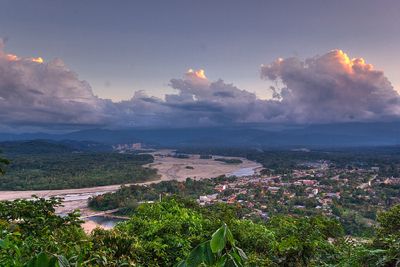Machia Park is well-known to many foreigner travelers, who often visit the animal refuge located near Villa Tunari in the Cochabamba Tropics in Central Bolivia. Some of these travelers, even stay a bit longer as volunteers with the organization Inti Wara Yassi [1], where they rehabilitate monkeys that had once been kept as pets, as well as protect some of the other wildlife located in the Park.
However, some of these volunteers are now leading the charge to protect Machia Park, as there is a current roads project that cuts through the middle of the Park. This new road is being built by the local municipality, so that it would make it easier for coca-growers to transport their crop. The conflict continues between the organization and local authorities, with critics of the plan saying that the project did not conduct the necessary Environmental Impact study, and that arrangements were not made to accommodate the displaced animals [2].
Some volunteers have been appealing directly through their blog at Inti Wara Yassi, describing what areas would be at risk [2]:
The monkey park, where several species of monkey are cared for and fed – capuchins, spider monkeys, squirrel monkeys.
Areas where tortoices, agoutis, coatis are kept.
The spider monkey park.
The enclosures for three of our felines – Leoncio, Gato and Luna
The “mirador” area, where abused and mistreated capuchin monkeys are rehabilitated.
The enclosure for the endangered Spectacled Bear.
Many of the trails which are used for walking the cats.This is why we have concluded that no consideration has been made for the wellbeing of the animals, not to mention the fact that Parque Machia is considered an area of National Heritage, meaning no damage to the biological, genetic and ecological diversity should be allowed.
The Democracy Center blog notes that some of the volunteers have employed [4] a “well-known Bolivian protest tactic, the road blockade, to try to stop construction of a new highway through the park.”
Gustavo Cardoso of the blog Observancia [es] credits Inti Wara Yassi for helping preserve nature in this area, which has provided direct benefits to the local municipality, which is the same entity that is building the new road [5].
Paradójicamente, en esta etapa donde la comunidad internacional, busca la conservación de áreas al máximo, todavía hay quienes conciben a ultranza que el desarrollo pasa por “dominar la naturaleza” tal cual se fraguaba en el siglo XIX, y que nos llevó a un estado de cosas que lamentamos hoy en día.
 [6]
[6]View of Villa Tunari from the Machia Park look-out by Nebarnix. Used under a Creative Commons license.
The blog Bolivia Bella notes that conservationist Jane Goodall [7]is scheduled to visit the park and could provide international attention on the case. She also sums up why the park should remain untouched [8]:
In any case, I AM against the building of THIS road. It's not right. It's a national park and nature preserve. It's very name indicates it has been set aside to AVOID its destruction. For me, that's enough reason to not agree with it. Period.
The sad thing is, I visited Villa Tunari several times and I saw first hand how Inti Wara Yassi volunteers cared for and loved the animals back to health. I was told most of the animals rescued and received at Machía were taken from their original habitats and sold to urban dwellers who, after realizing how large they grow, how dangerous they can be, how much care and food they need, or how long they actually live, abandon them or simply lock them up in cages for the rest of their lives, or worse, abuse them.
Many of the animals have been severely abused and will not be able to live on their own in the wild – ever. Others may be re-inserted but this is a very long and gradual process. You can’t just move animals to a new place. It requires a lot of logistics and they many never be able to adapt to a new situation. In the case of some of these animals haven't they been put through enough already as it is!
